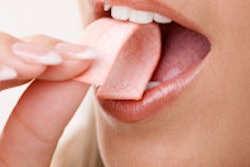
Most dental professionals believe xylitol chewing gum prevents caries in children and adolescents. But according to a new literature review, it's not clear whether it works better than other forms of sugarless gum.
Seven of the eight controlled trials published to date on xylitol-containing chewing gum indicate daily use of the gum reduces caries in children and adolescents. However, a literature review on the topic also found only one of the eight studies included a control group of people chewing gum without xylitol, and that none was randomized.
Hence, the jury is still out on whether any method of increasing saliva production has the same salubrious effect as chewing xylitol-containing gum, according to the authors of the literature review. They presented their findings last week at the University of Toronto Faculty of Dentistry 2012 Research Day.
Xylitol, a sugar alcohol that has become a popular sugar substitute, is incorporated into several dental hygiene products, including sugarless gums such as B-Fresh (0.85 grams of xylitol in every piece), Spry (0.72 grams/piece), and Trident (0.17 grams/piece).
The American Academy of Pediatric Dentistry has endorsed the use of xylitol "as part of a preventive strategy aimed specifically at long-term caries pathogen suppression and caries reduction in higher risk populations," and encourages xylitol-containing products be labeled clearly with regard to their xylitol content "to enable dentists and consumers to ensure therapeutic levels of exposure."
But are there gaps in the evidence regarding xylitol-containing gum's caries-preventive effects in the pediatric population? To find out, Jennie Kuretzky and several other University of Toronto undergraduate dentistry students, under the supervision of doctoral candidate Dania Sabbahi, BDS, MSc, searched the published literature for studies on the topic.
Lower caries rates
The researchers identified eight controlled trials, the largest of which was a 40-month study of 1,277 students in Belize who chewed xylitol-containing gum sticks or pellets between three and 10 times per day (Journal of Dental Research, December 1995, Vol. 74:12, pp. 1904-1913).
The eight studies were carried out in Belize, Canada, Finland, and Lithuania, and participants ranged in age from 6 to 15 years. The dropout rate ranged from 11.5% to 54.2%. The total xylitol dosage ranged from 2.95 grams per day to 10 grams per day. None of the studies was randomized, and only one included a sugarless-gum control group (Community Dentistry and Oral Epidemiology, August 2001, Vol. 29:4, pp. 278-288). This study also included a second, no-gum control group.
The studies yielded caries-reduction rates with xylitol gum compared with no gum of 33% to 93% (all p < 0.01). Significant dose effects were reported in four of the studies.
In the single study with a sugarless-gum control group, however, the researchers found no significant reduction in caries load: The average number of decayed, missing, and filled surfaces in the xylitol-gum group was 8.1; the average number in the sugarless-gum control group was 8.3; and 12.4 was the average in the no-gum control group.
"Compared to not chewing gum, the evidence shows xylitol gum is effective at reducing caries," Kuretzky told DrBicuspid.com. "But it's not clear whether it's due to the xylitol itself or to the salivary production from gum chewing. Saliva dilutes acid in the mouth, reduces the sugar burden, contains minute amounts of fluoride, and possesses an intrinsic pH-buffering capacity."
More studies are needed with sugarless-gum controls to determine the xylitol-specific effects on cavities, she said.



















